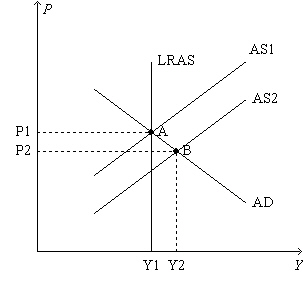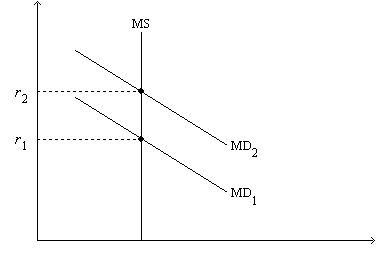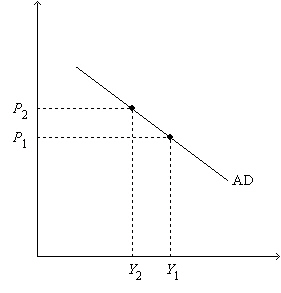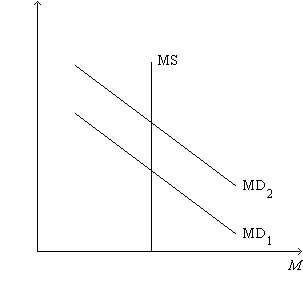Multiple Choice
Identify the
choice that best completes the statement or answers the question.
|
|
|
1.
|
Most economists use the aggregate demand and aggregate supply model primarily to
analyze
a. | short-run fluctuations in the economy. | b. | the effects of macroeconomic policy on the
prices of individual goods. | c. | the long-run effects of international trade
policies. | d. | productivity and economic growth. |
|
|
|
2.
|
Which of the following typically rises during a recession?
a. | garbage collection | b. | unemployment | c. | corporate
profits | d. | automobile sales |
|
|
|
3.
|
Real GDP
a. | is the current dollar value of all goods produced by the citizens of an economy
within a given time. | b. | measures economic activity and
income. | c. | is used primarily to measure long-run changes rather than short-run
fluctuations. | d. | All of the above are correct. |
|
|
|
4.
|
The model of short-run economic fluctuations focuses on the price level
and
a. | real GDP. | b. | economic growth. | c. | the neutrality of
money. | d. | None of the above is correct. |
|
|
|
5.
|
The average price level is measured by
a. | any real variable. | b. | the rate of inflation. | c. | the level of the
money supply. | d. | the CPI or the GDP deflator. |
|
|
|
6.
|
The aggregate demand and aggregate supply graph has
a. | the price level on the horizontal axis. The price level can be measured by the
GDP deflator. | b. | the price level on the horizontal axis. The price level can be measured by real
GDP. | c. | the price level on the vertical axis. The price level can be measured by the
GDP deflator. | d. | the price level on the vertical axis. The price level can be measured by
GDP. |
|
|
|
7.
|
The aggregate-demand curve shows the
a. | quantity of labor and other inputs that firms want to buy at each price
level. | b. | quantity of labor and other inputs that firms want to buy at each inflation
rate. | c. | quantity of domestically produced goods and services that households want to buy at
each price level. | d. | quantity of domestically produced goods and
services that households, firms, the government, and customers abroad want to buy at each price
level. |
|
|
|
8.
|
Which of the following effects helps to explain the downward slope of the
aggregate-demand curve?
a. | the exchange-rate effect | b. | the wealth effect | c. | the interest-rate
effect | d. | All of the above are correct. |
|
|
|
9.
|
Changes in the price level affect which components of aggregate demand?
a. | only consumption and investment | b. | only consumption and net
exports | c. | only investment | d. | consumption, investment, and net
exports |
|
|
|
10.
|
Other things the same, an increase in the price level makes the dollars people
hold worth
a. | more, so they can buy more. | b. | more, so they can buy less. | c. | less, so they can
buy more. | d. | less, so they can buy less. |
|
|
|
11.
|
When taxes increase, consumption
a. | decreases as shown by a movement to the left along a given aggregate-demand
curve. | b. | decreases as shown by a shift of the aggregate demand curve to the
left. | c. | increases as shown by a movement to the right along a given aggregate-demand
curve. | d. | increases as shown by a shift of the aggregate demand curve to the
right. |
|
|
|
12.
|
When the money supply increases
a. | interest rates fall and so aggregate demand shifts right. | b. | interest rates fall
and so aggregate demand shifts left. | c. | interest rates rise and so aggregate demand
shifts right. | d. | interest rates rise and so aggregate demand shifts
left. |
|
|
|
13.
|
The discovery of a large amount of previously-undiscovered oil in the U.S. would
shift
a. | the long-run aggregate-supply curve to the right. | b. | the long-run
aggregate-supply curve to the left. | c. | the aggregate-demand curve to the
left. | d. | None of the above is correct. |
|
|
|
14.
|
Which of the following would cause prices to fall and output to rise in the
short run?
a. | Short-run aggregate supply shifts right. | b. | Short-run aggregate
supply shifts left. | c. | Aggregate demand shifts
right. | d. | Aggregate demand shifts left. |
|
|
|
Figure 1.

|
|
|
15.
|
Refer to Figure 1. Starting from point B and assuming that
aggregate demand is held constant, in the long run the economy is likely to experience
a. | a falling price level and a falling level of output. | b. | a falling price
level and a rising level of output. | c. | a rising price level and a falling level of
output. | d. | a rising price level and a rising level of output. |
|
|
|
Optimism
Imagine that the economy is in long-run equilibrium. Then,
perhaps because of improved international relations and increased confidence in policy makers, people
become more optimistic about the future and stay this way for some time.
|
|
|
16.
|
Refer to Optimism. Which curve shifts and in which direction?
a. | aggregate demand shifts right | b. | aggregate demand shifts
left | c. | aggregate supply shifts right. | d. | aggregate supply shifts
left. |
|
|
|
17.
|
When production costs rise,
a. | the short-run aggregate supply curve shifts to the right. | b. | the short-run
aggregate supply curve shifts to the left. | c. | the aggregate demand curve shifts to the
right. | d. | the aggregate demand curve shifts to the left. |
|
|
|
18.
|
Which of the following will reduce the price level and real output in the short
run?
a. | an increase in the money supply | b. | an increase in oil prices | c. | a decrease in the
money supply | d. | technical progress |
|
|
|
19.
|
According to classical macroeconomic theory,
a. | output is determined by the supplies of capital and labor and the available
production technology. | b. | for any given level of output, the interest
rate adjusts to balance the supply of, and demand for, loanable funds. | c. | given output and the
interest rate, the price level adjusts to balance the supply of, and demand for,
money. | d. | All of the above are correct. |
|
|
|
Figure 2. On the left-hand graph, MS represents the supply of money
and MD represents the demand for money; on the right-hand graph, AD represents aggregate
demand. The usual quantities are measured along the axes of both graphs. .  |  | | |
|
|
|
20.
|
Refer to Figure 2. Which of the following quantities is held
constant as we move from one point to another on either graph?
a. | the nominal interest rate | b. | the quantity of money
demanded | c. | investment | d. | the expected rate of
inflation |
|
|
|
21.
|
Refer to Figure 2. If the money-supply curve MS on the left-hand
graph were to shift to the right, this would
a. | represent an action taken by the Federal Reserve. | b. | shift the AD curve
to the left. | c. | create, until the interest rate adjusted, an excess demand for money at the interest
rate that equilibrated the money market before the shift. | d. | All of the above are
correct. |
|
|
|
22.
|
If, at some interest rate, the quantity of money demanded is greater than the
quantity of money supplied, people will desire to
a. | sell interest-bearing assets, causing the interest rate to
decrease. | b. | sell interest-bearing assets, causing the interest rate to
increase. | c. | buy interest-bearing assets, causing the interest rate to
decrease. | d. | buy interest-bearing assets, causing the interest rate to
increase. |
|
|
|
23.
|
A decrease in the interest rate could have been caused by the money-demand curve
shifting
a. | leftward because the price level fell. | b. | leftward because the price level
rose | c. | rightward because the price level fell. | d. | rightward because
the price level rose. |
|
|
|
24.
|
Other things equal, in the short run a higher price level leads households
to
a. | increase consumption and firms to buy more capital goods. | b. | increase consumption
and firms to buy fewer capital goods. | c. | decrease consumption and firms to buy more
capital goods. | d. | decrease consumption and firms to buy fewer capital
goods. |
|
|
|
25.
|
The most important reason for the slope of the aggregate-demand curve is that as
the price level
a. | increases, interest rates increase, and investment decreases. | b. | increases, interest
rates decrease, and investment increases. | c. | decreases, interest rates increase, and
investment increases. | d. | decreases, interest rates decrease, and
investment decreases. |
|
|
|
26.
|
Fiscal policy refers to the idea that aggregate demand is affected by changes
in
a. | the money supply. | b. | government spending and
taxes. | c. | trade policy. | d. | All of the above are
correct. |
|
|
|
27.
|
The logic of the multiplier effect applies
a. | only to changes in government spending. | b. | to any change in
spending on any component of GDP. | c. | only to changes in the money
supply. | d. | only when the crowding-out effect is sufficiently
strong. |
|
|
|
Figure 3. On the figure, MS represents money supply and MD
represents money demand. 
|
|
|
28.
|
Refer to Figure 3. What is measured along the vertical axis of the
graph?
a. | the quantity of output | b. | the amount of crowding out | c. | the interest
rate | d. | the price level |
|
|
|
29.
|
The multiplier effect is exemplified by the multiplied impact on
a. | the money supply of a given increase in government purchases. | b. | tax revenues of a
given increase in government purchases. | c. | investment of a given increase in interest
rates. | d. | aggregate demand of a given increase in government
purchases. |
|
|
|
30.
|
As income rises
a. | money demand rises, so the interest rate rises. | b. | money demand rises,
so the interest rate falls | c. | money demand falls, so the interest rate
rises. | d. | money demand falls, so the interest rate falls. |
|
|
|
31.
|
Permanent tax cuts shift the AD curve
a. | farther to the right than do temporary tax cuts. | b. | not as far to the
right as do temporary tax cuts. | c. | farther to the left than do temporary tax
cuts. | d. | not as far to the left as do temporary tax cuts. |
|
|
|
32.
|
An increase in government spending on goods to build or repair
infrastructure
a. | shifts the aggregate demand curve to the right. | b. | has a multiplier
effect. | c. | shifts the aggregate supply curve to the right, but this effect is likely more
important in the long run. | d. | All of the above are
correct. |
|
|
|
33.
|
A reduction in U.S net exports would shift U.S. aggregate demand
a. | rightward. In an attempt to stabilize the economy, the government could raise
taxes. | b. | rightward. In an attempt to stabilize the economy, the government could cut
taxes. | c. | leftward. In an attempt to stabilize the economy, the government could raise
taxes. | d. | leftward. In an attempt to stabilize the economy, the government could cut
taxes. |
|
|
|
34.
|
During recessions, taxes tend to
a. | rise and thereby increase aggregate demand. | b. | rise and thereby
decrease aggregate demand. | c. | fall and thereby increase aggregate
demand. | d. | fall and thereby decrease aggregate demand. |
|
|
|
35.
|
The primary argument against active monetary and fiscal policy is that
a. | attempts to stabilize the economy do not constitute a proper role for government in a
democratic society. | b. | these policies affect the economy with a long
lag. | c. | these policies affect the economy too quickly and with too much
impact. | d. | history demonstrates that interest rates respond unpredictably to active policies,
leading to unpredictable effects on income. |
|
|
|
36.
|
Phillips found a negative relation between
a. | output and unemployment. | b. | output and employment. | c. | wage inflation and
unemployment. | d. | None of the above is correct. |
|
|
|
37.
|
If policymakers decrease aggregate demand, then in the short run the price
level
a. | falls and unemployment rises. | b. | and unemployment fall. | c. | and unemployment
rise. | d. | rises and unemployment falls. |
|
|
|
Figure 4. The left-hand graph shows a short-run aggregate-supply
(SRAS) curve and two aggregate-demand (AD) curves. On the right-hand diagram, U represents the
unemployment rate.
|
|
|
38.
|
Refer to Figure 4. What is measured along the vertical axis of the
right-hand graph?
a. | the interest rate | b. | the inflation rate | c. | the wage
rate | d. | the growth rate of the nominal money supply |
|
|
|
39.
|
By raising aggregate demand more than anticipated, policymakers
a. | reduce unemployment for awhile. | b. | raise unemployment for
awhile. | c. | reduce unemployment permanently. | d. | None of the above is
correct. |
|
|
|
40.
|
If the Federal Reserve increases the rate at which it increases the money
supply, then unemployment is lower
a. | in the long run and the short run. | b. | in the long run but not the short
run. | c. | in the short run but not the long run. | d. | in neither the short run nor the long
run. |
|
|
|
41.
|
In the long run an increase in the money supply growth rate effects
a. | the inflation rate and the natural rate of unemployment. | b. | the inflation rate,
but not the natural rate of unemployment. | c. | neither the inflation rate nor the natural rate
of unemployment. | d. | the natural rate of unemployment, but not the inflation
rate. |
|